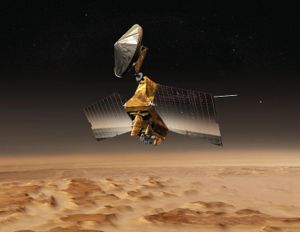Difference between revisions of "Mars Reconnaissance Orbiter"
m |
|||
| Line 30: | Line 30: | ||
[[Image:Mro_moons.png|thumb|left|200px|'''MRO''' images of both moons, [[Phobos]] and [[Deimos]] taken by the The Compact Reconnaissance Imaging Spectrometer for Mars (CRISM) instrument on Nov 27, 2007.]] | [[Image:Mro_moons.png|thumb|left|200px|'''MRO''' images of both moons, [[Phobos]] and [[Deimos]] taken by the The Compact Reconnaissance Imaging Spectrometer for Mars (CRISM) instrument on Nov 27, 2007.]] | ||
In an effort to characterize the 4 dimensional dynamics of the Mars [[atmosphere]] (3 spatial dimensions and time), the ''Mars Climate Sounder'' (''MCS'') is used to acquire profiles of the lower 50 miles of the atmosphere, including clouds, [[dust]], pressure and temperature.<ref>[http://mars.jpl.nasa.gov/mcs-redirect.html MCS homepage]</ref> | In an effort to characterize the 4 dimensional dynamics of the Mars [[atmosphere]] (3 spatial dimensions and time), the ''Mars Climate Sounder'' (''MCS'') is used to acquire profiles of the lower 50 miles of the atmosphere, including clouds, [[dust]], pressure and temperature.<ref>[http://mars.jpl.nasa.gov/mcs-redirect.html MCS homepage]</ref> | ||
| + | |||
| + | ==References== | ||
| + | {{reflist}} | ||
| − | |||
| − | |||
[[category:Orbiters]] | [[category:Orbiters]] | ||
Revision as of 10:43, 23 October 2018
Launched on August 12, 2005 by an Atlas V rocket from Cape Canaveral Air Force Station, the Mars Reconnaissance Orbiter (MRO) carrying HiRISE and other instruments arrived at Mars on March 10, 2006. However, it did not begin its main picture taking until November 2006. A long The NASA mission began taking data in November 2006 after completion of a long aerobreaking maneuver in the upper Mars atmosphere to place it in the desired orbit. The orbit has an inclination of 93 degrees, which means it orbits north and south in a polar orbit, as the planet turns beneath it.[1] As a result of the characteristics of its orbit, HiRISE takes pictures at about 3 p.m. local time. This time frame produces few shadows, but does avoid morning mist. To arrange for communications support during the arrival of the InSight Mars lander mission, the orbit was slightly modified on September 28, 2016 by a 75 second engine burn. [2] [3]
Orbit adjustments
MRO took seven and a half months to reach Mars. Although four trajectory corrections were planned and an additional fifth emergency maneuver was a possible, [4]only three trajectory correction maneuvers were used. This saved 60|lbs fuel that would be usable during MRO's extended mission.[5]
The craft approached Mars on March 10, 2006, and passing above its southern hemisphere at an altitude of 370-400km. All six of MRO's main engines burned for 27 minutes to slow the probe from 2900 to 1900 m/s.
The initial orbit was a highly elliptical polar orbit with a period of about 35.5 hours.[6] Soon after insertion, the periapsis – the point in the orbit closest to Mars – was 426 km from the surface.[6] The apoapsis – the point in the orbit farthest from Mars – was 44,500 km from the surface.
Aerobraking began on March 30, 2006. This three-step process only needed half the fuel to reach a lower, more circular orbit with a shorter period. First, during its first five orbits of the planet (one Earth week), MRO used its thrusters to drop the periapsis of its orbit into aerobraking altitude. This altitude depends on the thickness of the atmosphere because Martian atmospheric density changes with its seasons. Second, while using its thrusters to make minor corrections to its periapsis altitude, MRO maintained aerobraking altitude for 445 planetary orbits (about five Earth months) to reduce the apoapsis of the orbit to 450 km. This was done in such a way so as to not heat the spacecraft too much, but also dip enough into the atmosphere to slow the spacecraft down. After the process was complete, MRO used its thrusters to move its periapsis out of the edge of the Martian atmosphere on August 30, 2006.[7][8]
In September 2006 MRO fired its thrusters twice more to fine-tune its final, nearly circular orbit to approximately 250 to 31|km above the Martian surface, with a period of about 112 minutes.Cite error: Closing </ref> missing for <ref> tag
The Context Camera (CTX) yields images with a pixel resolution up to about 6 m. CTX is used to produce context maps for observations of HiRISE and CRISM, and to provide mosaics of large regions, monitor places for changes over time, and acquire stereo (3D) coverage of special regions and potential future landing sites.[9] [10] The optics of CTX consist of a 350 mm focal length
- ↑ Lyons, Daniel T. (August 5–8, 2002). "MARS RECONNAISSANCE ORBITER: AEROBRAKING REFERENCE TRAJECTORY" (PDF). AIAA/AAS Astrodynamics Specialist Conference and Exhibit. Archived from the original (PDF) on October 18, 2011. Retrieved March 9, 2012.
- ↑ NASA Mars Orbiter Preparing for Mars Lander's 2016 Arrival
- ↑ Mars orbiter prepares for next year's InSight lander arrival. July 29, 2015.
- ↑ Cite error: Invalid
<ref>tag; no text was provided for refs namedMars Reconnaissance Orbiter: Multimedia - ↑ Cite error: Invalid
<ref>tag; no text was provided for refs namedU.S. Spacecraft Enters Orbit Around Mars - ↑ 6.0 6.1 Cite error: Invalid
<ref>tag; no text was provided for refs namedNew Mars Orbiter Ready for Action - ↑ Cite error: Invalid
<ref>tag; no text was provided for refs namedaero - ↑ Cite error: Invalid
<ref>tag; no text was provided for refs namedMars Orbiter Successfully Makes Big Burn - ↑ Malin, M. C.; et al. (2007). "Context Camera Investigation on board the Mars Reconnaissance Orbiter". Journal of Geophysical Research. 112 (E05S04): 1–25. Bibcode:2007JGRE..112.5S04M. doi:10.1029/2006je002808.
- ↑ Harrison, Tanya N.; Malin, Michael C.; Edgett, Kenneth S. (2009). "Present-day activity, monitoring, and documentation of gullies with the Mars Reconnaissance Orbiter (MRO) Context Camera (CTX)". Geological Society of America Abstracts with Programs. 41 (7): 267. Bibcode:2009GSAA...41..267H.







